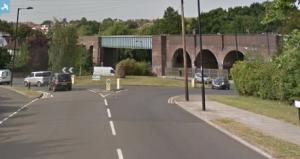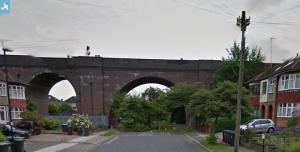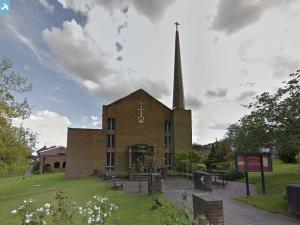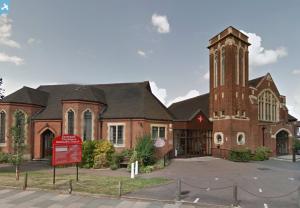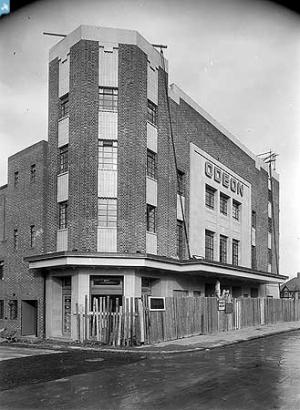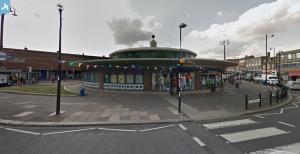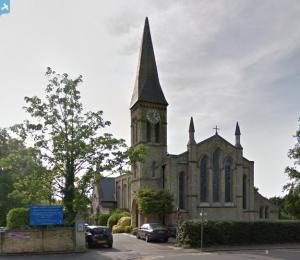 Hampden Square |

a christie |
Sunday 15th of March 2020 04:44:23 PM |
 Osidge Primary School,
Chase Side, London N14 5HD |

Art |
Tuesday 26th of February 2019 11:28:58 AM |
 Bramley Road, parallel to the A110, features an Edward VIII Royal Mail pillar box. Fairly rare but in keeping with the age of the houses in this road. |

Robin |
Tuesday 11th of July 2017 01:07:56 PM |
 Osidge Lane. |

Peter |
Tuesday 23rd of February 2016 08:24:51 PM |
 Avenue Road. |

Peter |
Tuesday 23rd of February 2016 08:22:24 PM |
 The De Bohun clock had a carillon that chimed "Boys & Girls Come Out to Play". Along with all tower bells it was silenced during the War, but not restarted after. Is it working these days? |

Peter |
Tuesday 23rd of February 2016 08:19:25 PM |
 "Grt North London Cemetery". |

Ray Flack |
Friday 10th of October 2014 05:40:38 PM |
 Hampden Way. |

Ray Flack |
Friday 10th of October 2014 05:38:34 PM |
 Ferney Road. |

Ray Flack |
Friday 10th of October 2014 05:37:19 PM |
 Brookside South. |

Ray Flack |
Friday 10th of October 2014 05:35:56 PM |
 Osidge Lane. |

Ray Flack |
Friday 10th of October 2014 05:33:20 PM |
 Woodfield Drive. |

Ray Flack |
Friday 10th of October 2014 05:32:05 PM |
 "Oak Hill Park". |

Ray Flack |
Friday 10th of October 2014 05:31:13 PM |
 Church Hill Road. |

Ray Flack |
Friday 10th of October 2014 05:30:08 PM |
 Russel Lane. |

Ray Flack |
Friday 10th of October 2014 05:29:00 PM |
 Brunswick Park Road. |

Ray Flack |
Friday 10th of October 2014 05:27:14 PM |
 Brownlow Road. |

Ray Flack |
Friday 10th of October 2014 05:20:05 PM |
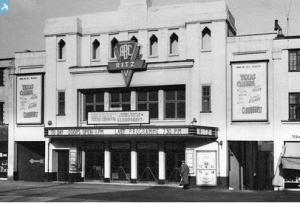  "Ritz Cinema". A406. Bowes Road.
Located in the north London district of Southgate. Built and designed by Major W.J. King as one of several Ritz Cinemas planned for a small chain, the project was sold to Associated British Cinemas (ABC) prior to completion. It opened as the Ritz Cinema on 21st December 1933 with Douglas Fairbanks Jr. in “The Narrow Corner” and John Wayne in “His Private Secretary”.
Styled in a rather plain Art Deco style, the auditorium runs parallel to the main Bowes Road (which today is part of the North Circular Road around London) and was hidden from view by a parade of shops. Inside the auditorium, the main features were a central dome in the ceiling and abstract decorative designs on the splay walls each side of the proscenium. The Ritz Cinema was equipped with a Compton 3Manual/10Rank theatre organ which was opened by Alex Taylor. Additional facilities included a cafe and a large car park.
It was re-named ABC from 1969 and in April 1970 it was fitted out as a ‘Luxury Lounge’ cinema with new spacious seating and carpeting in the stalls area which now contained 588 seats, while the balcony became un-used.
The ABC closed on 16th February 1974 with Brigitte Bardot in “The Legend of Frenchie King” (Les Petroleuses) and Leslie Phillips in “Not Now Darling”. It lay empty for a while and was then purchased by Jehovah’s Witnesses who now use it as an Assembly Hall. It has been well maintained and restored to near original condition.
Located in the north London district of Southgate. Built and designed by Major W.J. King as one of several Ritz Cinemas planned for a small chain, the project was sold to Associated British Cinemas (ABC) prior to completion. It opened as the Ritz Cinema on 21st December 1933 with Douglas Fairbanks Jr. in “The Narrow Corner” and John Wayne in “His Private Secretary”.
Styled in a rather plain Art Deco style, the auditorium runs parallel to the main Bowes Road (which today is part of the North Circular Road around London) and was hidden from view by a parade of shops. Inside the auditorium, the main features were a central dome in the ceiling and abstract decorative designs on the splay walls each side of the proscenium. The Ritz Cinema was equipped with a Compton 3Manual/10Rank theatre organ which was opened by Alex Taylor. Additional facilities included a cafe and a large car park.
It was re-named ABC from 1969 and in April 1970 it was fitted out as a ‘Luxury Lounge’ cinema with new spacious seating and carpeting in the stalls area which now contained 588 seats, while the balcony became un-used.
The ABC closed on 16th February 1974 with Brigitte Bardot in “The Legend of Frenchie King” (Les Petroleuses) and Leslie Phillips in “Not Now Darling”. It lay empty for a while and was then purchased by Jehovah’s Witnesses who now use it as an Assembly Hall. It has been well maintained and restored to near original condition.
|

Ray Flack |
Friday 10th of October 2014 05:15:51 PM |

Powys Lane. |

Ray Flack |
Friday 10th of October 2014 05:00:07 PM |
 Wilmer Way. |

Ray Flack |
Friday 10th of October 2014 04:58:39 PM |
 Morton Way. |

Ray Flack |
Friday 10th of October 2014 04:56:14 PM |
 "Viaduct".
As seen from Waterfall Rd, junction with Hampden Way, on right. / Morton Way, on Left. |

Ray Flack |
Friday 10th of October 2014 04:52:01 PM |
 "Arnos Park". |

Ray Flack |
Friday 10th of October 2014 04:39:51 PM |
 Waterfall Road. |

Ray Flack |
Friday 10th of October 2014 04:38:55 PM |
 A1110. Bowes Road. |

Ray Flack |
Friday 10th of October 2014 04:37:10 PM |
 Betstyle Road. |

Ray Flack |
Friday 10th of October 2014 04:35:21 PM |
 Ravenscraig Road. |

Ray Flack |
Friday 10th of October 2014 04:34:22 PM |
 Brookdale. |

Ray Flack |
Friday 10th of October 2014 04:33:37 PM |
  "Arnos Grove Station".
The station was opened on 19 September 1932 as the most northerly on the first section of the Piccadilly line extension from Finsbury Park to Cockfosters. It was the terminus of the line until services were further extended to Oakwood on 13 March 1933. Its name was chosen after public deliberation: alternatives were "Arnos Park", "Bowes Road" and "Southgate".
Like the other stations Charles Holden designed for the extension, Arnos Grove was built in a modern European style using brick, glass and reinforced concrete and basic geometric shapes. A circular drum-like ticket hall of brick and glass panels rises from a low single-storey structure and is capped by a flat concrete roof. The design was inspired by the Stockholm City Library and Swedish architect Gunnar Asplund. A similar design was employed by Holden for the rebuilding of Chiswick Park on the District line (also in 1932), although the drum there is supplemented with an adjacent brick tower. The centre of the ticket hall is occupied by a disused ticket office (a passimeter in London Underground parlance) which houses an exhibition on the station and the line. In July 2011 Arnos Grove became a Grade II* listed building.[7] The building is one of the 12 "Great Modern Buildings" profiled in The Guardian during October 2007,[8] and was summarised by architectural critic Jonathan Glancey as "...truly what German art historians would describe as a gesamtkunstwerk, a total and entire work of art." |

Ray Flack |
Friday 10th of October 2014 04:30:41 PM |
 A1004. Cannon Hill. |

Ray Flack |
Friday 10th of October 2014 04:17:57 PM |
 "Christ Church, Southgate".
A1003. The Green. / Waterfall Road. |

Ray Flack |
Friday 10th of October 2014 04:15:55 PM |
  "Oakwood Underground Station".
The station opened on 13 March 1933 as part of the Cockfosters extension, its original name being Enfield West. The station did not appear on the original plans to extend the Piccadilly line beyond Finsbury Park, which only provided for seven additional stations, however it served as the line's terminus for a brief period before Cockfosters station was opened. The station building is a fine example of the architecture Charles Holden built for the Piccadilly line extensions, with a large and imposing box-shaped ticket hall surrounded by lower structures containing shops. The ceiling of the booking hall is particularly monumental and bold. The whole design mirrors proportions found in classical architecture, albeit in a distinctly 20th century structure. The dimensions of the ticket hall are approximately a "double-cube" (its front elevation is roughly twice its height and width). The station is similar to Holden's slightly earlier designs for Sudbury Town and Acton Town stations at the western end of Piccadilly line. Oakwood Station is a Grade II* listed building.
Like other extensions of the London Underground lines, the opening of the Cockfosters extension stimulated the rapid development of new suburbs and much of the open countryside that existed in 1930 when construction started was quickly covered by new housing developments. |

Ray Flack |
Friday 10th of October 2014 04:07:24 PM |
 Queen Elizabeths Drive. |

Ray Flack |
Friday 10th of October 2014 04:02:23 PM |
 Raleigh Way. |

Ray Flack |
Friday 10th of October 2014 03:59:22 PM |
 St Thomas Road. |

Ray Flack |
Friday 10th of October 2014 03:58:19 PM |
 Winchmore Hill Road. |

Ray Flack |
Friday 10th of October 2014 03:57:03 PM |
 The Vale. |

Ray Flack |
Friday 10th of October 2014 03:55:29 PM |
 Mayfair Terrace.
"Viaduct between Oakwood Station and Southgate".
|

Ray Flack |
Friday 10th of October 2014 03:53:03 PM |
 Lakenheath. |

Ray Flack |
Friday 10th of October 2014 03:40:04 PM |
 Kenwood Ave. |

Ray Flack |
Friday 10th of October 2014 03:38:37 PM |
 Carlton Ave. |

Ray Flack |
Friday 10th of October 2014 03:38:00 PM |
 Shouth Lodge. |

Ray Flack |
Friday 10th of October 2014 03:37:11 PM |
 Grosvenor Grds. |

Ray Flack |
Friday 10th of October 2014 03:36:33 PM |
 Belgrave Grds. |

Ray Flack |
Friday 10th of October 2014 03:35:07 PM |
 "Oakwood Park". |

Ray Flack |
Friday 10th of October 2014 03:32:04 PM |
 "St Thomas's Church C of E".
St Thomas's is a modern Anglican church established in the 1930s as the suburb of Oakwood grew with the extension of the Piccadilly underground line to Cockfosters. Building stopped with the outbreak of the Second World War, and the church was not finished until the 1950s. The architect was Romilly Craze. Later a parish hall was added, and a distinctive tall green spire. There is a guide hut on the grounds across the car park from the main building.
Late in 2010 the spire was found to be unsafe and removed, however this was replaced at the beginning of 2012.
|

Ray Flack |
Friday 10th of October 2014 03:28:45 PM |
 Sheringham Ave. |

Ray Flack |
Friday 10th of October 2014 03:19:44 PM |
 Prince George Ave. |

Ray Flack |
Friday 10th of October 2014 03:18:42 PM |
 Chase Road. |

Ray Flack |
Friday 10th of October 2014 03:17:15 PM |
 Green Road. |

Ray Flack |
Friday 10th of October 2014 03:16:30 PM |
 Reservoir Road. |

Ray Flack |
Friday 10th of October 2014 03:15:54 PM |
 The Bourne. |

Ray Flack |
Friday 10th of October 2014 03:13:26 PM |
This is Bourne Hill, N13, which starts from the end of The Bourne, N14, at the eastern side of Grovelands Park, where the houses before The Woodman, N13 are. |

downloader141 |
Saturday 19th of August 2017 10:12:53 AM |
 "Southgate Methodist Church": The Bourne |

Ray Flack |
Friday 10th of October 2014 03:10:40 PM |
 Fox Lane. |

Ray Flack |
Friday 10th of October 2014 03:03:31 PM |
 "Odeon Cinema Southgate": The Bourne.
A view of the cinema under construction in 1935. It was designed by Bertie Crewe and cost £26,163 to build. |

Ray Flack |
Friday 10th of October 2014 03:01:49 PM |
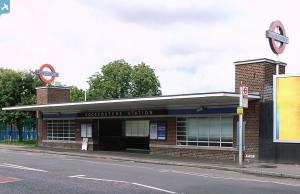  "Cockfosters Station".
The station opened on 31 July 1933, the last of the stations on the extension of the line from Finsbury Park to do so and four months after Oakwood station (then called Enfield West) opened. Prior to its opening, "Trent Park" and "Cock Fosters" (an early spelling of the area's name) were suggested as alternative station names. The original site hoarding displayed the name as a single word.
The station was designed by Charles Holden in a modern European style using brick, glass and reinforced concrete. Compared with the other new stations Holden designed for the extension, Cockfosters' street buildings are modest in scale, lacking the mass of Oakwood or Arnos Grove or the avant-garde flourish of Southgate. Holden's early design sketches show the station with two towers. The most striking feature of the station is the tall concrete and glass trainshed roof and platform canopies which are supported by portal frames of narrow blade-like concrete columns and beams rising from the platforms and spanning across the tracks. The trainshed roof constructed at Uxbridge in 1937-38 was built to a similar design. Cockfosters station is a Grade II listed building.
The station has three tracks with platforms number 1 to 4; the centre track being served from both sides by platforms 2 and 3. This is an example of the so-called Spanish solution. Most eastbound Piccadilly trains terminate here although some terminate at Oakwood or Arnos Grove, particularly in peak hours or in the evenings. Cockfosters depot is located between Oakwood and Cockfosters and trains can access or leave it from either direction. |

Ray Flack |
Friday 10th of October 2014 02:50:22 PM |
 "Southgate Underground Station".
Southgate station opened on 13 March 1933 with Oakwood on the second phase of the northern extension of the Piccadilly line from Finsbury Park to Cockfosters. Prior to the station's opening, alternative names were suggested including "Chase Side" and "Southgate Central". On opening, local residents were given a free return ticket to Piccadilly Circus. |

Ray Flack |
Friday 10th of October 2014 02:45:00 PM |
 A111. Chase Side. |

Ray Flack |
Friday 10th of October 2014 02:35:34 PM |
 "De Bohn School": Green Road. |

Ray Flack |
Friday 10th of October 2014 02:34:11 PM |
 Wood Ave. |

Ray Flack |
Friday 10th of October 2014 02:33:40 PM |
 Trent Grds. |

Ray Flack |
Friday 10th of October 2014 02:33:13 PM |
 De Bohnun Ave. |

Ray Flack |
Friday 10th of October 2014 02:21:32 PM |
 Green Road. |

Ray Flack |
Friday 10th of October 2014 02:20:47 PM |
 A110. Bramley Road. |

Ray Flack |
Friday 10th of October 2014 02:17:26 PM |
 "Christ Church Cockfosters": Chalk Lane. |

Ray Flack |
Friday 10th of October 2014 02:06:59 PM |
 "Later became": Edgeworth Road. |

Ray Flack |
Friday 10th of October 2014 01:56:02 PM |
 Park Road. |

Ray Flack |
Friday 10th of October 2014 01:52:56 PM |
 Lakeside Cres. |

Ray Flack |
Friday 10th of October 2014 01:50:42 PM |
 Daneland. |

Ray Flack |
Friday 10th of October 2014 01:50:08 PM |
 Freston Grds. |

Ray Flack |
Friday 10th of October 2014 01:47:48 PM |
 Heddon Court Ave. |

Ray Flack |
Friday 10th of October 2014 01:47:05 PM |
 Heddon Road. |

Ray Flack |
Friday 10th of October 2014 01:42:18 PM |
 Ashurst Road. |

Ray Flack |
Friday 10th of October 2014 01:41:32 PM |
 Cat Hill. |

Ray Flack |
Friday 10th of October 2014 01:37:08 PM |
 "East Barnet School". |

Ray Flack |
Friday 10th of October 2014 01:36:27 PM |
 Ridgeway Ave. |

Ray Flack |
Friday 10th of October 2014 01:35:45 PM |
 Belmont Ave. |

Ray Flack |
Friday 10th of October 2014 01:34:39 PM |
 Belmont Ave. |

Ray Flack |
Friday 10th of October 2014 01:33:26 PM |
 Mount Pleasant. |

Ray Flack |
Friday 10th of October 2014 01:30:59 PM |
 Mount Pleasant. |

Ray Flack |
Friday 10th of October 2014 01:16:50 PM |
 A111. Cockfosters Road. |

Ray Flack |
Friday 10th of October 2014 01:15:21 PM |
 "Trent Park Gates". |

Ray Flack |
Friday 10th of October 2014 01:14:21 PM |
 A111. Cockfosters Road. |

Ray Flack |
Friday 10th of October 2014 01:12:20 PM |
During and just after the war there were futuristic looking carriages parked in the sidings between Cockfosters and Enfield West (now Oakwood) stations. Were they ever used for public services? |

East Barnet Stan |
Wednesday 9th of March 2016 10:16:34 PM |
 Kent Drive. |

Ray Flack |
Friday 10th of October 2014 01:10:49 PM |
 Gloucester Grds. |

Ray Flack |
Friday 10th of October 2014 01:10:17 PM |
 Sussex Way. |

Ray Flack |
Friday 10th of October 2014 01:09:08 PM |
 Westpole Ave. |

Ray Flack |
Friday 10th of October 2014 01:07:54 PM |
 Approach Road. |

Ray Flack |
Friday 10th of October 2014 01:07:12 PM |



























































































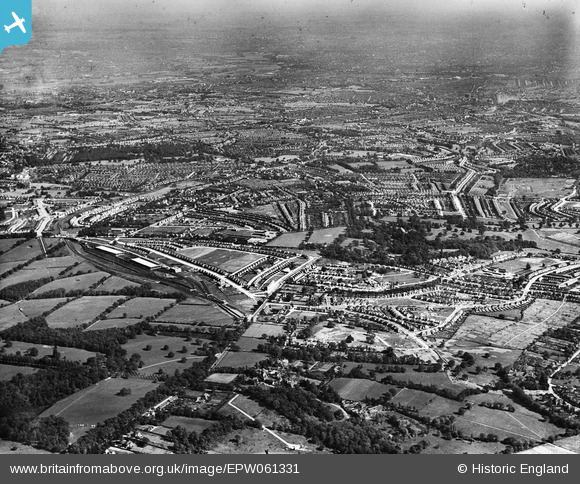
![[EPW061331] East Barnet and Southgate, Cockfosters, from the north-west, 1939](http://britainfromabove.org.uk/sites/all/libraries/aerofilms-images/public/100x100/EPW/061/EPW061331.jpg)
![[EPW053172] Cockfosters Underground Station, the Piccadilly Line and environs, Cockfosters, from the north-west, 1937](http://britainfromabove.org.uk/sites/all/libraries/aerofilms-images/public/100x100/EPW/053/EPW053172.jpg)


